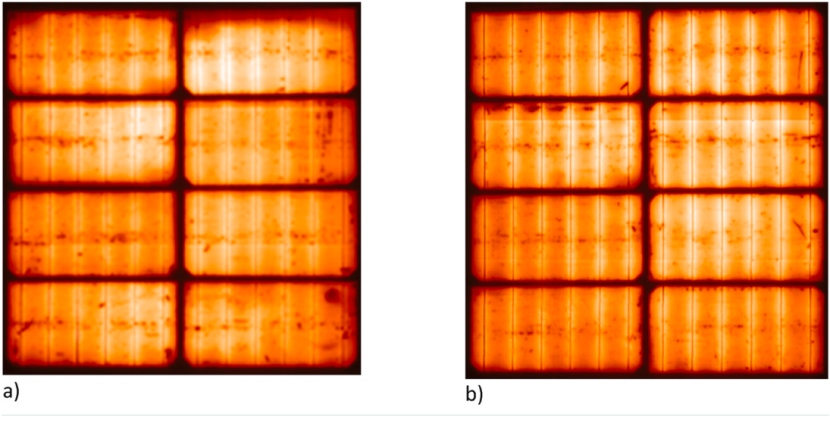The French National Solar Energy Research Institute (CEA-INES) recently announced that it has successfully developed a new photovoltaic module interconnection technology. This technology significantly reduces the silver consumption of photovoltaic modules by using low-silver content electrically conductive adhesive (ECA), copper ribbon and silver-copper metallization paste. Ultimately, the total silver usage of photovoltaic modules is only 14 milligrams per watt (mgAg/W), reducing silver consumption by 26%.

EL image of bare copper ribbon interconnected with ECA after 600 TC
CEA-INES, part of the French Alternative Energies and Atomic Energy Commission (CEA), evaluated three different conductive adhesive formulations in this project to ensure compatibility with copper strips with different coating materials, including silver, bare copper, and silver-tin mixed materials. "We found that low-silver conductive adhesives showed higher performance and reliability than previous generation products, and had better reliability," said Rémi Monna, head of the research.
In the journal Solar Materials and Solar Cells, Mona and his team published a paper titled "Application of Cu Ribbon and Cu-Ag HJT Cell Metallization in Photovoltaic Modules Interconnected on an ECA Basis". In the study, they used mini modules made of M2-type n-type Czochralski wafers and polyolefin elastomer (POE) encapsulation materials for experiments. Compared with traditional screen printing technology, the research team chose template printing technology because it has obvious advantages in deposition repeatability.
In accordance with the IEC 61215 standard, the researchers conducted damp heat (DH) and thermal cycle (TC) aging tests on the modules, and measured electrical parameters after 100, 200, 400 and 600 thermal cycles, focusing on the fill factor of the modules and electroluminescence imaging to reveal possible increases in series resistance and interconnect failures. “To evaluate the adhesion of the interconnect ribbon to the solar cell metallization, the team used a peel test,” the paper states.
The results showed that cells and modules with silver metallization degraded by less than 2% after 3,000 hours of damp heat aging, while cells with copper metallization showed moisture degradation after 2,000 hours, with the degree of degradation similar to that of fully silver metallized modules.
In addition, the researchers found that replacing silver metallized cells with silver-copper metallized cells significantly reduced the amount of silver used in the module, requiring only 14 mgAg/W of total silver. Silver consumption can be reduced by up to 26% when using a low-silver content conductive adhesive in combination with bare copper ribbon.
"We have conducted a preliminary cost analysis, but we still need to conduct more detailed studies with partners, taking into account product characteristics, production volumes and other specific requirements of industrial production lines," Monaghan explained. "Implementing this innovation requires close cooperation with equipment manufacturers, especially in the screen printing and interconnection stages, and cooperation with material suppliers is also crucial.
Most of our partners are located in Europe, which is an important advantage for us." Monaghan also said that CEA-INES is currently planning to test this innovation in actual production lines. "We are working closely with 3Sun to solve the problem of reducing the use of silver in photovoltaic modules," he said. "In addition, some of the innovations we are developing can also be transferred to other cell technologies, so they are also potentially attractive to other manufacturers."
In January this year, CEA-INES cooperated with 3Sun, an Italian heterojunction solar module manufacturer (part of Enel), to successfully achieve a photoelectric conversion efficiency of 30.8% for a two-terminal perovskite-silicon tandem solar cell. In March 2022, they also jointly developed a DC/DC maximum power point tracker (MPPT) and successfully achieved a photoelectric conversion efficiency of 24.47% for indium-doped p-type heterojunction silicon solar cells.